-
 Breakfast is the Most Important Meal of the Day: 10 Nutritious and Easy-to-Make Indian Breakfast Recipes to Start Your Day (2019)
Breakfast is the Most Important Meal of the Day: 10 Nutritious and Easy-to-Make Indian Breakfast Recipes to Start Your Day (2019)
-
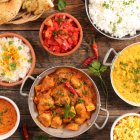 Learn Some Popular Indian Food Recipes: 11 Dishes That Prove Just How Simple It Can Be to Cook in Your Kitchen Versus Relying on Takeout (2019)
Learn Some Popular Indian Food Recipes: 11 Dishes That Prove Just How Simple It Can Be to Cook in Your Kitchen Versus Relying on Takeout (2019)
-
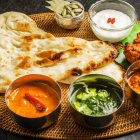 Learning How to Cook Indian Food Can Be Easy! Try These 15 Incredibly Delicious Indian Recipes That Will Make You Want to Cook Instead of Calling for Take Out
Learning How to Cook Indian Food Can Be Easy! Try These 15 Incredibly Delicious Indian Recipes That Will Make You Want to Cook Instead of Calling for Take Out
The Difference Between Khara Pongal and Sweet Pongal

So What Comprises a Typical Pongal Menu?
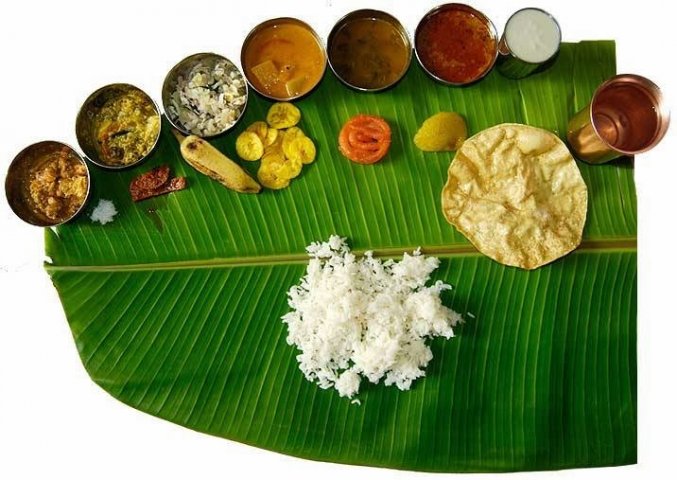
The Breakfast Menu

What's Served for Lunch or Dinner

6 Mouth-Watering Pongal Recipes
Paal Pongal in Pongal Paanai
Paal pongal is the basic pongal that is cooked on pongal day. It has little to no taste on its own hence it is customary to serve it with pongal kuzhambu. It tastes best when cooked in a bronze pot.
Ingredients:
- Raw rice - 1 cup
- Milk - 5 cups
- Salt
Recipe:
- Wash the rice and set it aside.
- Add milk to the bronze pot and bring it to boil.
- Once it boils over, add the washed rice and let it cook until it is half cooked.
- At this point add salt. Mix the rice occasionally with a ladle as it cooks.
- Keep cooking until the rice is soft and mushy.
- Serve it with pongal kuzhambu.
- For more information, click here
Sweet Pongal in Pongal Paanai
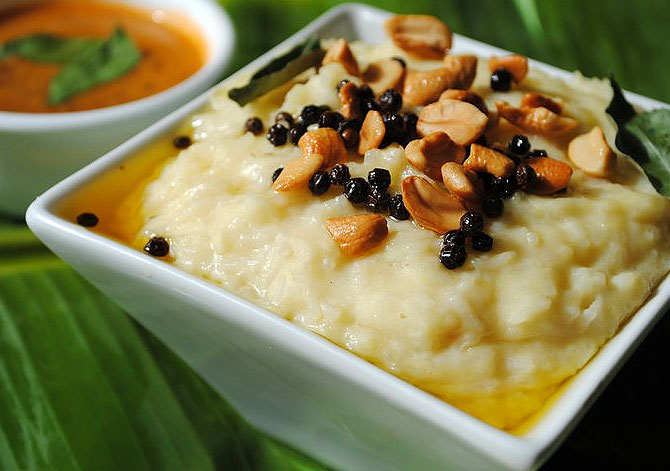
Sarakarai pongal or sweet pongal is a delicacy which is made during Pongal and offered for the Gods. It is prepared not just during Pongal but also during other auspicious occasions. It is also shared as a prasad in the temples after being offered to God.
Ingredients:
- Raw rice - 1 cup
- Moong Dal - ¼ cup
- Ghee - 4 tbsp
- Milk - 1 - 1 ½ cup
- Jaggery - 1 cup
- Water - 3 - 4 cups
- Raisins - 1 tbsp
- Cashews - 2 tbsp
Recipe:
- To start with, wash the raw rice with 1 cup of water and save the water.
- Add the washed water, 1 ½ milk and 1 cup of water in a pongal paanai and bring it to a boil.
- As the milk boils and rises up, drizzle some water. The milk will now subside.
- Add the rice and moong dal to the milk.
- Let it cook until it is little more than soft which means the rice needs to be cooked more than usual.
- Keep an eye on the water level. Add more if needed.
- Take the jaggery with a little water and bring it to boil. The mixture should have the consistency of a paste.
- Filter and add it to the rice and mix it well.
- Take a small pan and heat ghee.
- Add cashews to the hot ghee and wait until it has turned golden.
- Then add the raisins until they balloon up and pop.
- Add this mixture to the rice. Your sweet pongal is ready to be served.
- For more information, click here
Temple Style Venpongal
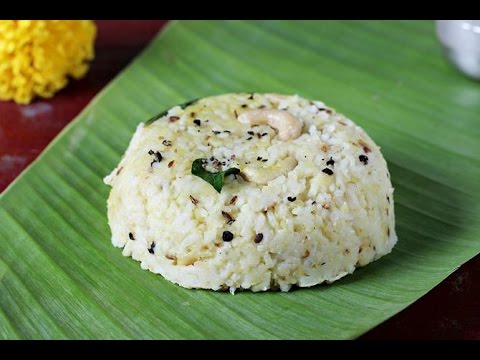
Ven Pongal or khara pongal is one of the most favorite breakfast in whole South India. The combination of rice and dal makes it one of the nutritious breakfasts and is also filling. It is also shared among the devotees in temples after being offered to God.
Ingredients:
- Raw rice - 1 cup
- Moong dal - 1 cup
- Water - 6 cups
- Ghee - 2 tsp
- Oil - 2 tsp
- Mustard - 1 tsp
- Cumin - 1 tsp
- Peppercorns - 1 tsp
- Asafoetida
- Ginger - 1 inch
- Curry Leaves - 2 sprigs
- Coriander leaves
- Salt - to taste
Recipe:
- Dry roast the moong dal until it is golden brown.
- Wash the raw rice and add it to the moong dal.
- In a pressure cooker add the rice and moong dal mix along with 6 cups of water.
- Pressure cook it for 3 whistles. Let the pressure die down on its own.
- Open the cooker and ensure the rice and the dal are mushy and soft to touch.
- In a small pan, add oil and ghee and wait for it to get hot.
- Once it’s hot, add the mustard seeds and wait for them to sputter.
- Then add cumin, pepper, curry leaves, crushed ginger and a pinch of asafoetida.
- Add the mixture and salt to the cooked rice and dal. Make sure to add salt little by little and mix everything thoroughly.
- Add coriander leaves at the last and serve it hot with sambar and chutney.
- For more information, click here
Dalia Pongal
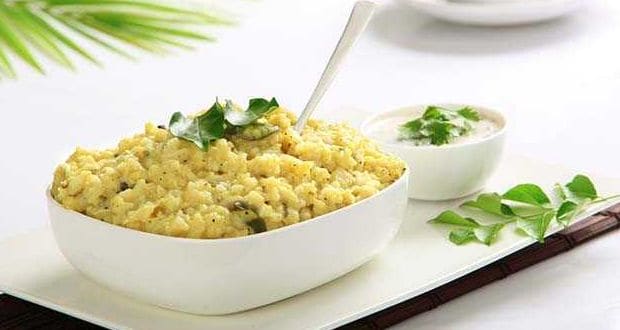
Pongal is one of the most loved breakfast down south. However, the calorie content is high due to the presence of rice and ghee. Adding wheat rava instead of rice makes it easier for the stomach and is an apt breakfast when you want something light yet delicious.
Ingredients:
- Wheat rava - 1 cup
- Moong dal - ½ cup
- Ghee - 2 tbsp
- Peppercorn - 1 tsp
- Cumin - 1 tbsp
- Cashew nuts - 1 tbsp
- Ginger - 1 inch
- Asafoetida
- Turmeric powder
- Curry leaves - 2 sprigs
- Salt
Recipe;
- Wash the wheat rava and moong dal separately. You will need to cook them in separate pressure cookers.
- Add 3 cups of water to wheat rava and pressure cook them.
- Take 1 cup of water, moong dal and add a pinch of turmeric powder, 1 tsp ghee and a pinch of asafoetida. Pressure cook them in another vessel.
- Heat a small pan and add ghee. When the ghee is hot add cumin, finely chopped ginger, pepper, asafoetida and finally add cashews. When the cashews are golden, remove it from the heat.
- Mix cooked rava, moong dal, salt and the tadka mix together thoroughly.
- Serve it hot with chutney.
- For more information, click here
Kodo Millet Ven Pongal
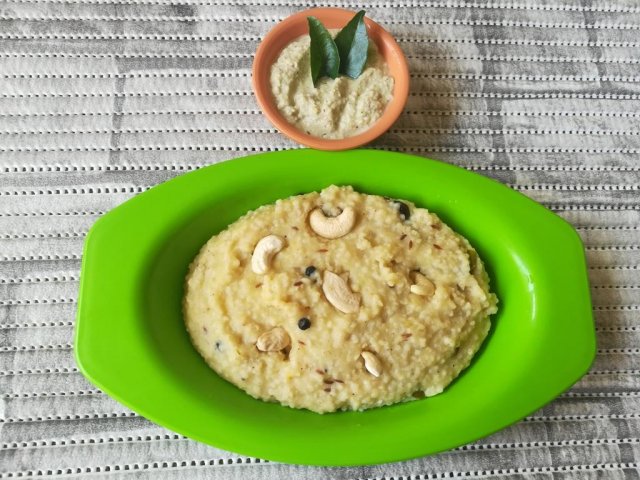
Millets are the new superfoods. Though they have been rediscovered in recent times, they were around since a long time. Millets have a low glycemic index, low in cholesterol and are gluten-free. Kodo Millet otherwise called as Varagarisi has B vitamins, folic acid, calcium, potassium, iron, magnesium and zinc.
Ingredients:
- Kodo millet - ½ cup
- Moong dal - 2 tbsp
- Water - 2 ¼ cup
- Ghee - 2 tsp
- Oil - 1 tbsp
- Cumin - 1 tsp
- Peppercorn - 1 tsp
- Curry leaves - 1 sprig
- Ginger - 1 tbsp finely chopped
- Cashew nuts
- Salt
Recipe:
- Dry roast the moong dal until it turns golden. Wash the millet and moong dal well before use.
- Add the moong dal and kodo millet along with water and salt to a pressure cooker. Pressure cook it for 4 whistles.
- Wait for the pressure to subside on its own and open the cooker.
- In a small pan add ghee, oil, cumin, peppercorn and cashew nuts. After the cumin sizzles, add curry leaves and chopped ginger.
- Add this mixture to the pressure cooker and mix the contents well.
- Healthy kodo millet pongal is ready to be served. Serve it hot with chutney and sambar.
- For more information, click here
Foxtail Millet Sweet Pongal
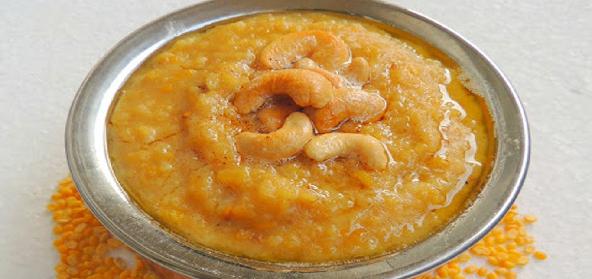
Millets are a much-coveted alternative for rice due to the fact that they don't alter the taste much. Hence, rice enthusiasts can enjoy a much healthier version without having to worry much about calories. Foxtail millet is one of the oldest grain crops and is known to reduce the cholesterol in our body. It is also ideal for diabetics due to its low glycemic index.
Ingredients:
- Foxtail millet - ½ cup
- Moong dal - 1 ½ tbsp
- Ghee - 1 ½ tbsp
- Water - 2 cups
- Jaggery - 1 cup
- Raisins - 7
- Cashew - 6
- Cardamom powder - ¼ tsp
Recipe:
- Dry roast the moong dal and foxtail millet together until they are hot to touch.
- Pressure cook them in 2 cups of water for about 4 whistles.
- Dissolve jaggery in a small amount of water and filter to remove any contamination.
- Boil it in a medium flame for about 3 minutes. Add the cooked mix of millet and moong dal to the jaggery water.
- Mix well and cook until jaggery gets incorporated well into the millet and dal. Also, add cardamom powder.
- In a separate small pan or tadka pan, add ghee and when it’s hot, add cashew nuts and raisins. Wait until the cashews are golden and the raisins are popped, and add this mixture to the millet and dal.
- Delicious foxtail millet sweet pongal is ready for you to gorge on.
Three Must-Have Pongal Side Dishes
As much as ven pongal and sweet pongal take the spotlight on Pongal day, there are a few side dishes that are a must-have during Pongal. We cannot list everything for you but these three take the crown.
Moong Dal Sambhar
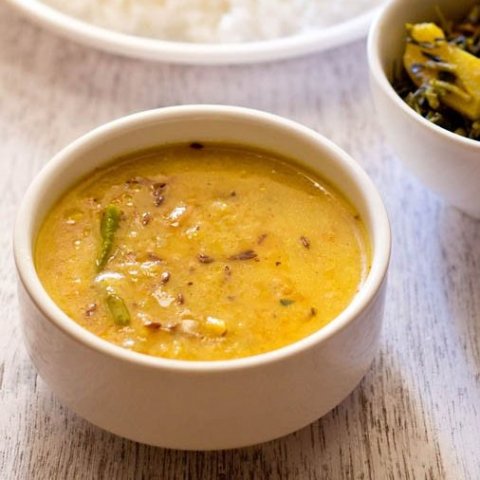
Pongal is a very heavy dish that needs something light to be easy on your digestive system. This quick and easy moong dal sambhar is the perfect combination for your ven pongal.
Ingredients:
- Onion - 2
- Tomato - 2
- Potato - 1
- Brinjal - 1
- Carrot - 1
- Moong dal - ¼ cup
- Oil - 2 tsp
- Mustard seeds - 1 tsp
- Asafoetida - ¼ tsp
- Urad dal - ¾ tsp
- Sambar Powder - 1 tsp
- Curry leaves - 2 sprig
Recipe:
- Wash the vegetables and chop them finely.
- Pressure cook moong dal along with carrot, brinjal and potato for 3 whistles.
- In a kadai, take oil and add mustard seeds and asafoetida.
- After the mustard pops, add urad dal and curry leaves.
- Wait until the urad dal turns brown and add onions. Saute them until they go transparent.
- Add the tomatoes and saute them until they go mushy.
- Add the pressure cooked dal and vegetable mix and then add sambar powder, salt and 1 cup of water.
- Boil the mixture in medium heat for 10 minutes.
- Garnish with coriander leaves. Your sambar is ready to be served.
Pongal Kuzhambu
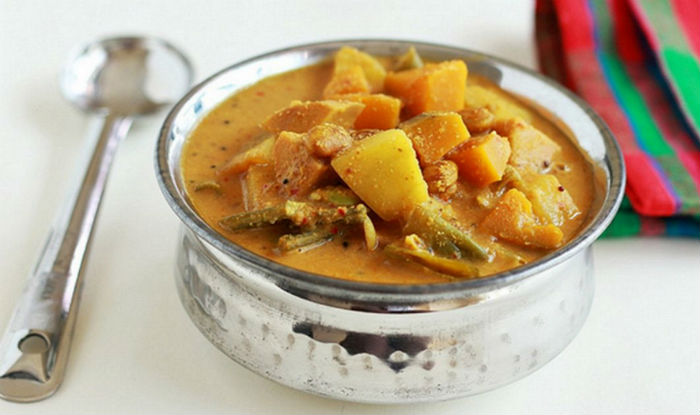
Pongal kuzhambu is a side dish prepared during Pongal with mixed country veggies. It is a perfect side dish for paal pongal(milk pongal) and sarkarai pongal (sweet pongal).
Ingredients:
- Mixed country vegetables - 3 cups
- Small onion - 15
- Tomato - 2
- Garlic - 2tsp
- Tamarind - ¼ cup
- Salt
- Turmeric powder - 1/4 tsp
- Red chilli powder - 1 tbsp
- Coriander powder - 2 tbsp
- Sambar powder - 1 tsp
- Fennel - 1 tsp
- Fenugreek - 1 tsp
- Curry leaves - 1 sprig
Recipe:
- Wash the vegetables and chop them into bite-sized pieces.
- Take little water in a bowl and extract juice from the tamarind.
- In a heavy bottomed kadai, add oil and heat it.
- Add fennel seeds, fenugreek seeds and also curry leaves.
- Once it splutters, add onions and garlic and saute until the onion becomes transparent.
- Then add tomatoes and once they are mushy add the vegetables along with turmeric powder, chilli powder, coriander powder, salt and sambar powder.
- Once the vegetables are cooked add the tamarind water and allow it to get incorporated in the vegetables.
- Boil for a few minutes until it reaches the correct consistency of curry.
- Your pongal kuzhambu is ready to be served with your favorite variety of pongal.
Urad Dal Vada

If there is a side dish that fits pongal perfectly it is urad dal vada. It is a common snack in southern states and is often had with tea.
Ingredients:
- Urad dal (skin removed) - 1 cup
- Raw rice - ½ tsp
- Green chillies - 2
- Roasted gram - ½ tsp
- Salt
- Oil
Recipe:
- Soak the urad dal, raw rice and the roasted gram for 30 minutes and refrigerate for another an hour.
- Drain the mixture and grind it along with the green chillies and salt. The batter should be smooth without any lumps. Take care not to add any water in order to prevent the batter from being diluted. If needed sprinkle water now and then.
- Heat oil in a deep kadhai. Once the oil reached the necessary temperature it is ready to cook the vada.
- Wet your hands and take some batter in your palms. Flatten it and make a hole in the middle.
- Slide the vada in the hot oil carefully.
- Fry it until is golden on both sides. Take it out and place it on a paper towel to drain the excess oil.
- Your vada is ready to be served. Serve it hot with chutney or sambar.
- Or you can soak it in rasam and make rasa vada.
-
 Simple and Easy-To-Create Pongal Kolam Designs To Decorate Your Home Traditionally
Simple and Easy-To-Create Pongal Kolam Designs To Decorate Your Home Traditionally
-
 This Diwali, Prepare to Welcome Goddess Lakshmi with a Mix of Traditional and Contemporary Décor: Unique Diwali Decoration Ideas for Your Home to Make It Look Spectacular Like Never Before! (2020)
This Diwali, Prepare to Welcome Goddess Lakshmi with a Mix of Traditional and Contemporary Décor: Unique Diwali Decoration Ideas for Your Home to Make It Look Spectacular Like Never Before! (2020)
-
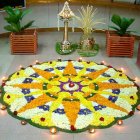 Creating Pookalams is One of the the Most Important Rituals of Onam: Make it Special with these Beautiful Onam Pookalam Designs (2020)!
Creating Pookalams is One of the the Most Important Rituals of Onam: Make it Special with these Beautiful Onam Pookalam Designs (2020)!
-
 Turn an Ordinary Saree into a Head Turner with a Border! 10 Gorgeous Saree Borders That will Jazz Up Your Saree, Plus Styling Tips to Show it Off (2020)
Turn an Ordinary Saree into a Head Turner with a Border! 10 Gorgeous Saree Borders That will Jazz Up Your Saree, Plus Styling Tips to Show it Off (2020)
-
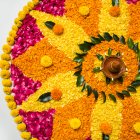 10 Exquisite Pongal Rangoli Designs to Celebrate the Harvest Festival With and Why You Should Practice This Ancient Art (2020)
10 Exquisite Pongal Rangoli Designs to Celebrate the Harvest Festival With and Why You Should Practice This Ancient Art (2020)
Dip Yourself in The Exquisite Taste of These Dishes on Pongal
Light, healthy and tasty are the main characteristics of these Pongal dishes. So if you like foods which are both tasty and easy to digest, you must give these recipes a try. So, what are you waiting for?

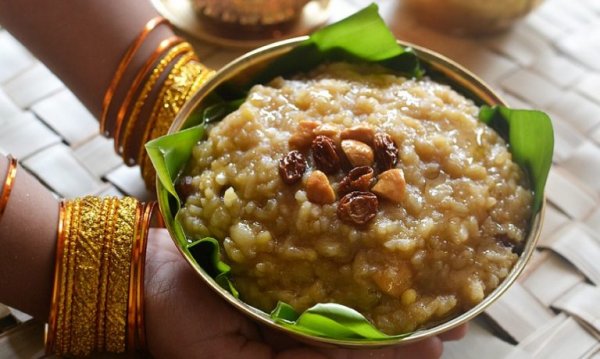
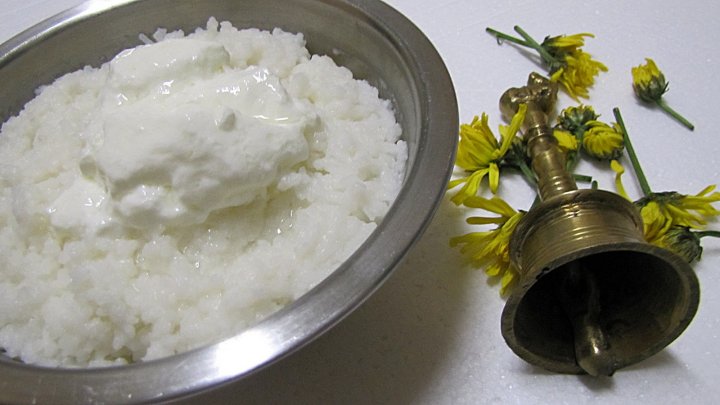
 Highlight the Best Facets of Your Incomparable Beauty: Discover the Best Face Highlighter Currently Available in India and Everything You Need to Know About Using Face Highlighters for Maximum Effect (2023)
Highlight the Best Facets of Your Incomparable Beauty: Discover the Best Face Highlighter Currently Available in India and Everything You Need to Know About Using Face Highlighters for Maximum Effect (2023)
 Forget the Blemishes and Get that Picture Perfect Flawless Radiance on Your Face: Check out the Best Foundations for Oily Skin Currently Available in India and Everything You Need to Know About Makeup Foundations (2023)
Forget the Blemishes and Get that Picture Perfect Flawless Radiance on Your Face: Check out the Best Foundations for Oily Skin Currently Available in India and Everything You Need to Know About Makeup Foundations (2023)
 Make Your Presence Felt Wherever You Go: Discover the Best Perfumes Under 2000 for Both Men and Women to Announce Your Arrival and Make Any Occasion Memorable (2023)
Make Your Presence Felt Wherever You Go: Discover the Best Perfumes Under 2000 for Both Men and Women to Announce Your Arrival and Make Any Occasion Memorable (2023)
 Protect Your Oily Skin from the Harmful Rays of the Sun: Discover the Best Gel Based Sunscreens for Oily Skin and Everything You Need to Know Before Buying One (2023)
Protect Your Oily Skin from the Harmful Rays of the Sun: Discover the Best Gel Based Sunscreens for Oily Skin and Everything You Need to Know Before Buying One (2023)
 Minor Blemishes and Wrinkles Affecting Your Confidence? Check out the Best BB Creams to Conceal Your Worries and Nourish Your Skin to Restore the Healthy, Radiant and Glowing Complexion Back Again (2023)
Minor Blemishes and Wrinkles Affecting Your Confidence? Check out the Best BB Creams to Conceal Your Worries and Nourish Your Skin to Restore the Healthy, Radiant and Glowing Complexion Back Again (2023)
